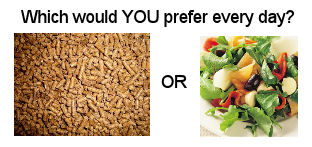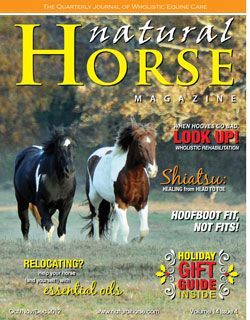For those of you with IR horses or horses that are exhibiting symptoms of IR. For those of you who have heard, “No grass! No apples! No carrots! No watermelon!” For those of you who hear, “He’ll have to eat nothing but NC/LS grain for the rest of his life.” For those who hear, “Oh! Can’t feed food that is high on the Glycemic scale! It’s gotta be below 10!” … etc. etc. You might want to read this: Glycemic Index vs Glycemic Load.
It is a PDF file and you’ll need the adobe acrobat reader to read it. You can download it for free here. 
It’s all about the FOOD! .. Fresh, live forages … Fruits, vegetables, nuts, seeds — all those things that you *know* are best for your horse to eat! Even grass! You discover its NOT ABOUT GLYCEMIC INDEX numbers but about the GLYCEMIC LOAD! Carrots have been named a major culprit in Insulin Resistance and with a GI of 71% one would think, OMG! 71% glycemics is just way, WAY too much for an IR horse to eat! Read it again … the GLYCEMIC LOAD is just 7.2%. That’s right. 7.2%. A carrot or two is not going to put your horse over the edge AS LONG AS he or she is getting plenty of FRESH foods and in a good ‘variety’ of fresh food daily.
Know what I did with my IR horse? (When I finally got a handle on all this.) … I put her back out on grass, fed her salads daily and got rid of ALL her supplements, her processed, special LC/LS feed, stopped soaking her hay and even gave her peppermint candies now and then. And you know what else? SHE THRIVED on that! Absolutely thrived. The changes in her body and mind were evident in just a few days after stopping all processed foods. She gain energy, she became alert and interested in life again; over the course of a couple of months lost her ‘old age’ look and became vibrant and in good weight again. She lost the fat pockets over her eyes, her shoulders, her rump … she even gained muscle again! The change in her was remarkable. And the testimonies from others who have done the same with their horses are the same. Increased health, vibrancy, alertness, curiosity, playfulness — their horses are feeling GOOD again!
So before letting your heart sink to the bottom of your toes when the vet says, “You’re horse has Insulin Resistance. Get him off the grass; he can never eat carrots or apples again.” etc. etc. … do your own research and find out for yourself. Find out what the difference is between Glycemic Index and Glycemic Load. Proactively think things through instead of simply reacting in fear. Research Diabetes Type II and find out just what it is. Not just the scientific or medical studies but also the alternative and complementary studies and evidence also. I think you’ll be surprised!
Again … the article is here: Glycemic Index vs Glycemic Load.












Just reading more and finding that some indexes show Beet Pulp to have a glycemic index of 1 – 5 % !!! so I guess even the experts can’t agree on it all. That’s why its so important to trust the horses! *grin*
This is a chart from the Journal of Animal Science that shows the Glycemic Index % of average equine foods:
http://jas.fass.org/content/83/13_suppl/E22/F2.expansion.html
Judging from this, Glycemic index % less than 50-075 (even 100? — Beet Pulp is considered OK for IR horses! ?? ) … would be acceptable. I, personally, feel that below 50% is OK
There’s a chart here: http://4.bp.blogspot.com/-mBXbE9Y_TwI/TZvCt6paVCI/AAAAAAAAEuA/A345ubDmKQY/s1600/GIfruitandveggies.jpg of veggies and fruits. You can see that, for the most part, their glycemic index is far below that of most feeds for horses.
Interesting, eh?
Great article. Now I can feel better about giving a little carrot to my IR mini gelding! But, what do the numbers mean? What would be the cut-off point for glycemic load? Obviously, from the examples in the article, most fruits and veggies would be low–especially when compared to processed foods– but does the same scale apply to load as to the index?
I think I agree with Phyllis’ comment, also there has got to be improved leptin signalling and insulin sensitivity.
There’s a lot to be said about eating “clean”-no processed food, fresh live enzymes, etc. Wonder if it regenerates the liver and normalizes the organs allowing them to function at optimum?
Good info. Thanks for the article!